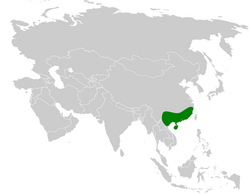| Chestnut bulbul | |
|---|---|
 | |
| Scientific classification | |
| Kingdom: | Animalia |
| Phylum: | Chordata |
| Class: | Aves |
| Order: | Passeriformes |
| Family: | Pycnonotidae |
| Genus: | Hemixos |
| Species: | H. castanonotus |
| Binomial name | |
| Hemixos castanonotus R. Swinhoe, 1870 | |
 | |
| Synonyms | |
| |
The chestnut bulbul or chestnut-backed bulbul (Hemixos castanonotus) is a songbird in the bulbul family, Pycnonotidae. The species was first described by Robert Swinhoe in 1870. It is found in southern China and northern Vietnam. Its natural habitat is subtropical or tropical moist lowland forests; it primarily resides in the canopy. [2]

